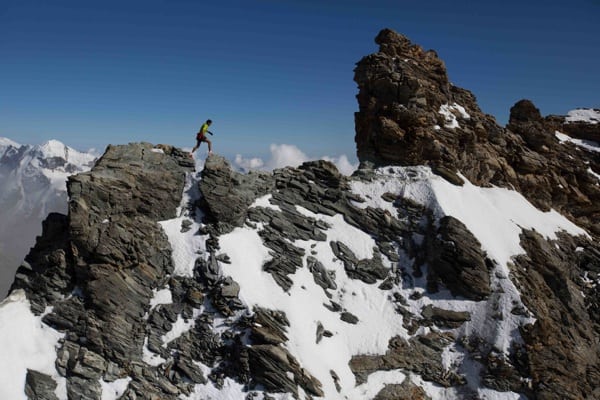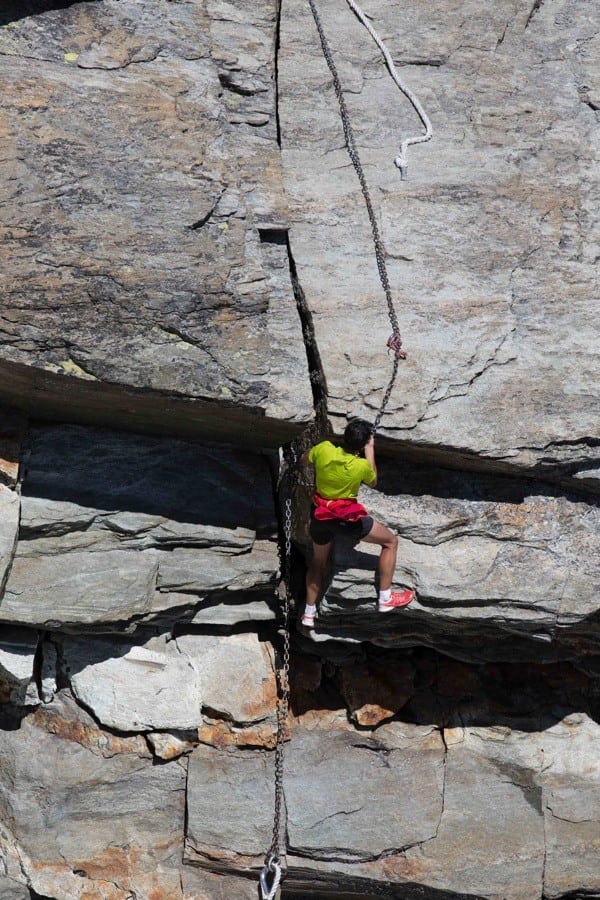[Editor’s Note: On August 21, mountain athlete Kilian Jornet re-set the Matterhorn speed record. He ran, hiked, scrambled, and climbed from the small Italian town of Breuil-Cervinia, situated on the Matterhorn’s southwest side, to the Matterhorn’s 14,692-foot summit, and back down to Breuil-Cervinia again. The route was just over 10.8 miles long and involved 8,100 vertical feet of ascent and descent. In short, he left the church in the center of town, ran and hiked northward on a non-technical track for about six kilometers, and then scrambled to the Colle del Leone (what Kilian refers to as “Leone pass”). From the pass, it’s a due-east scramble and climb on the Cresta del Leone (what Kilian describes as the “ridge”), past the Rifugio Carrel (a hut used by Matterhorn climbers that Kilian references), over Pic Tyndall (a Matterhorn sub-peak that Kilian describes as “Tyndall”), and onto the summit. From the pass to the summit, the route is rated class 5.3 when climbers use the fixed ropes along the route. And, of course, Kilian descended mostly the way he came, taking a small deviation below “Leone pass.” It took him one hour, 56 minutes, 15 seconds for the ascent and a round-trip time of two hours, 52 minutes, two seconds. The previous record of three hours, 14 minutes, 44 seconds was set in 1995 by Italian Bruno Brunod.
We published two additional stories related to the Matterhorn the day we published this story: Matterhorn of the Gods, which talks of drawing inspiration from others, and a History of the Matterhorn.]

Photo: Seb Montaz
iRunFar: On your Summits of My Life Facebook page, you were quoted as having said that you’ve had a love for the Matterhorn since you were young. How did that love come about? Why that mountain as opposed to some of the other iconic peaks in Europe or the world?
Kilian Jornet: The Matterhorn is very iconic in Europe. It has the perfect form, a perfect pyramid. Like Alpamayo, Ama Dablam, Shivling, K2, they’re mountains with an aesthetic. Then there is all the history about the first climbs, about its north face that I read when I was a child. And I had a big picture of the Matterhorn in my room until I was 12!
iRF: You were young, seven or eight I think, when Bruno Brunod set the previous record. If your relationship with the mountain came about as a child, when did you first learn about his record?
Jornet: When I started ski-mountaineering competition at 13, I learned about Bruno Brunod. Everybody talked about his record. It was in my mind always, like an impossible thought, and then a motivating thought.

Photo: Seb Montaz
iRF: Your new record of 2:52:02 is a huge betterment of Brunod’s 3:14:44. You must have looked at your watch at interim points to see that you were gaining on his record. What was going through your mind?
Jornet: I was running around Bruno’s times until the Leone pass. I was thinking, I wanted to run faster in this not-technical, first part, to be more safe on the ridge later, but there I was just two or three minutes under the record. Then, I feel super good on the ridge. I was moving fluid, and I saw that I was winning minutes in the uphill. When I was at Tyndall, I saw I was 13 minutes under, and on the summit 15 minutes under. But I was afraid about the downhill. For me, I thought it was impossible to run under one hour. I was thinking it was possible to run down in one hour, 15 minutes. So I ran as fast as I could. I didn’t take risks on the ridge but I run always fluid, just in the limit of my confidence. At the Leone pass, I saw I was still winning time, so then I feel it was possible.
iRF: And, when you returned to the Cervinia church and stopped your watch, what was the first thought that went through your mind?
Jornet: I was happy. I think this is the most interesting thing I’ve done in my running career. And I was tired. I was at 100 percent all way up and down. Normally in races, I go at 80 percent, so it was super fun to give everything.
iRF: Your ascent rate was something like 4,000 feet per hour and your descent rate was over 8,600 feet per hour. Um, wow. I think I saw Brunod as being quoted on your Summits of My Life blog as having predicted your record very closely. What did you think you could do with his record? What was your plan?
Jornet: Yes, Bruno the day before, he tells me that he thinks I can do 2 hours, 52 minutes. I was thinking, he jokes! He knows me better than myself. My plan here was not a plan. In a lot of races, you can play strategy, that minds go slowly, and just push in some moments. Here the plan was to give everything and see the chrono at the finish. I had in mind Bruno’s times and I was looking at them. But I was thinking it would be possible to climb faster to Leone pass and then lose time to his record on the ridge, and then lose more time to his record on the technical downhill.

Photo: Seb Montaz
iRF: What is it like to have a legend like Bruno Brunod cheering and rooting for you to break his record?
Jornet: It’s really inspiring. He is a nice, nice person, really humble and he is huge! He was there some days before to share some informations, and the day of the attempt with his kids to cheer running up and down! We were talking a lot of his races, when he was 10 minutes behind [Ricardo] Mejía or [Matt] Carpenter and he wins by more than five minutes after the downhill. I’m really happy that he was there, to share this with him. His record was inspiring and motivating me for 15 years to keep training and racing.
iRF: The technicality of this Matterhorn route is very low as there are fixed ropes that negate most areas with technical ‘issues.’ I think the ‘risky’ part of your record was not in actual mountain conditions but in your ascent and descent rates. Especially your descent rate is so fast. You said in an interview with the Italian newspaper Aosta Sera that you feel like you didn’t have to take many risks for that speed. There’s a video from bystander Martin Mikloš at the Rifugio Carrel on YouTube that shows you slipping once while holding a fixed rope. What was the level of risk you decided was an acceptable level? What was too much? Like, were you willing to take a hard but non-life-threatening fall or did you manage your risks even lower than that?
Jornet: The route is less technical than Innominata Ridge, for example. It’s a third to fourth-class climbing and then the ropes. But the difficulty is that you need to downclimb, too, and fast, fast. Is not a difficult route, but it’s an exposed route. You can run most parts, or jump in lot of parts, but if you slide or if you don’t put your feet where you want, you die. Where there are ropes it’s not a problem, because if you slide (I slid once, just before the hut) you have the rope, so you can run fast. But there are just seven or eight ropes, the rest is without. I was running fast but always feeling in my comfort zone, close but in the line of my safety.

Photo: Seb Montaz
iRF: Where did you feel the strongest? And, were there any moments where you doubted yourself?
Jornet: I feel not strong but fluid and fast on the ridge, and all the way down. The doubting moments was the uphill until Leone pass.
iRF: According to an interview with Desnivel.com, you and Brunod talked in detail about his record and your attempt tactics. What did you talk about?
Jornet: In this kind of record attempt, it is not much about tactic. It is to give everything. It is also a lot about routes, shortcuts, how to glide in the snow, where to drink from rivers. So we talked about that. He gave me all the informations about his record.
iRF: I understand you climbed in the afternoon so that fewer climbers would be on the route. Did you encounter others and have to navigate around them?
Jornet: Yes, I started at 3 p.m. It was perfect. I just passed three or four teams and no one on the mountain, just the mountain guides of Cervinia to validate and to help me in case.
iRF: There’s a pretty iconic image by Seb Montaz of you touching the Matterhorn’s summit cross. What did that moment feel like? Elation? Were you thinking about the descent? A combination of feelings?
Jornet: I felt a bit relieved to have some extra minutes on the record to take more confidently the downhill. I was happy to break the uphill time and excited to start to have fun on the downhill.
iRF: I notice from video and images of your outing that are now on the Internet, you didn’t have a jacket when you started, but you did have a jacket right after you passed the hut on your ascent. And you had one at the finish. Also, in these images, there are folks all over the mountain who are kind of pointing the way in a very general sense. Did you stash your jacket somewhere? Were those people on the mountain there just for you?
Jornet: I put a jacket in the hut day the before when I climbed. On the way down, I took it with me because I didn’t want to climb to get it the day after. The people on the mountain were mountain guides and Guarda di Fianza. They were there to control the record (chrono, checking the times, seeing where I was), to ask other climbers to wait if I came to a rope, and in case I had an accident. They was super enthusiastic and helpful. Here in Cervinia there are the guides to validate and check the record. They did this also for Valerio [Bertoglio], Bruno…

Photo: Seb Montaz
iRF: After setting this record, you took a couple easy days before racing and winning the Matterhorn Ultraks race. Were you tired on race day? Were you enlivened by what had happened earlier in the week?
Jornet: I was tired in general, but in good shape. So I ran easy and went for the win in the last kilometers.
iRF: Which Salomon shoe did you wear for the record? How were they different from the production model?
Jornet: I was with a Sense with a Speedcross sole, with a softer rubber.

Photo: Seb Montaz
